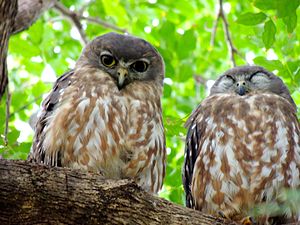Kläfferkauz
| Kläfferkauz | ||||||||||
|---|---|---|---|---|---|---|---|---|---|---|

A pair of barkers' owls |
||||||||||
| Systematics | ||||||||||
|
||||||||||
| Scientific name | ||||||||||
| Ninox connivens | ||||||||||
| ( Latham , 1801) |
The Kläfferkauz ( Ninox connivens ) is a medium-sized owl species from the genus of the bush owl ( Ninox ). The name refers to the owl's call, which is similar to a dog's bark.
The Kläfferkauz is widespread in Australia and New Guinea and a resident bird in all parts of its distribution area . Several subspecies are distinguished. The IUCN classifies the existing situation as safe ( least concern ).
features
The Kläfferkauz reaches a body length of 38 to 44 centimeters, of which 14.3 to 19.8 centimeters are on the tail. The weight is between 425 and 510 grams. There is no noticeable gender dimorphism .
The forehead, the crown and the face veil are gray-brown. The back and the coat are gray-brown, the shade of gray being a bit more intense. The elytra are smoky gray-brown with small white spots. The arm and hand wings are slightly darker than the wing covers and are very narrow, whitish, striated across. The tail is gray-brown with five to six whitish horizontal stripes. The throat is light brown to whitish brown and has gray-brown longitudinal stripes. The underside of the body is cream-colored with noticeable vertical stripes. The brownish hues of these vertical stripes and their density vary greatly from person to person. The barrels are feathered. The eyes are yellow. The wax skin of the beak is gray. The beak is dark horn-colored to blackish.
Distribution area and habitat
The distribution area of the Kläfferkauz are the northern Moluccas, New Guinea and the less arid regions of Australia. In some regions, such as Queensland and New South Wales, the Kläfferkauz is a very common species. The Kläfferkauz also inhabits some of the islands off the coast of Australia. It is absent in arid regions and those regions that do not have tall trees. It is a resident bird in the entire distribution area.
The habitat are forests of the temperate and subtropical climatic zone. It also occurs in narrow strips of forest along rivers and along forest edges. In foothills, the bark owl is also found in regions that have only a few forest patches near swamps and other wetlands. In New Guinea it is mainly found in the lowlands. On the island of Karkar it occurs at altitudes up to 1040 meters.
Way of life
The Kläfferkauz is generally crepuscular and nocturnal, but on cloudy winter days it occasionally begins to hunt before dusk. He usually lives in pairs that occupy a territory year-round. Within their territory they have sleeping and resting places that they keep looking for. These are usually located in a deciduous tree within a group of trees. The couples usually rest there in close proximity to one another. If there are more than two barking owls resting together, this is usually this year's offspring.
Kläfferkäuze are generally not very shy and can often be found in rural regions near settlements.
The yeast owl's diet consists of small mammals and birds as well as large insects and other invertebrates. In the south of Australia, rabbits represent a large part of its prey. Birds are beaten up to the size of a flute bird and an owl swallow . Prey that the barking owl cannot swallow whole is torn to pieces with its beak. It occasionally catches bats and insects in flight.
Reproduction
The breeding season of the Kläfferkauz falls from July to September. It usually nests in natural tree hollows. The nest is five to ten meters above the ground. Wherever suitable tree hollows are lacking, it occasionally nests in crevices in the rock and even in rabbit burrows. The clutch consists of two to three eggs, which are laid two to three days apart. It only breeds the female. The breeding season is about 36 days. The nestlings can fledge at an age of five to six weeks. They are cared for by the parent birds for a while. They reach sexual maturity at around one year of age.
literature
- del Hoyo, J .; Collar, NJ; Christie, DA; Elliott, A .; Fishpool, LDC 2014: HBW and BirdLife International Illustrated Checklist of the Birds of the World. Barcelona, Spain and Cambridge UK: Lynx Edicions and BirdLife International.
- Claus König, Friedhelm Weick, Jan-Hendrik Becking: Owls of the World . 2nd Edition. Christopher Helm, London 2008, ISBN 978-0-7136-6548-2 .
Web links
- Ninox connivens inthe IUCN 2016.10 Red List of Threatened Species . Posted by: BirdLife International, 2016. Retrieved January 21, 2017.
- BirdLife International: Species Factsheet - Barking Owl ( Ninox connivens ) . Retrieved January 21, 2017.
- Call of the barker owl on Xeno-Canto
Single receipts
- ↑ a b c König et al .: Owls of the World , p. 452.
- ↑ Ninox connivens in the Red List of Endangered Species of the IUCN 2016.10. Posted by: BirdLife International, 2016. Retrieved January 21, 2017.
- ↑ a b König et al .: Owls of the World , p. 451.

